|
|
 |
"Lawrence will always be remembered as the inventor
of the cyclotron, but more importantly, he should be remembered as the
inventor of the modern way of doing science."
—Luis Alvarez, winner of the
1968 Nobel Prize for Physics
Lawrence Berkeley National Laboratory is the namesake and legacy of its
founder, Ernest Orlando Lawrence, winner of the 1939 Nobel Prize for Physics
for his invention of the cyclotron.
Yes, Lawrence was the inventor of the cyclotron, the granddaddy of today's
most powerful accelerators. Yes, he was the "father of big science,"
the first to advance the idea of doing research with multidisciplinary
teams of scientists and engineers. But these facts alone do not explain
why Nobel-laureate scientists such as Edwin McMillan, Luis Alvarez, Melvin
Calvin and Glenn Seaborg continued to speak of themselves as members of
Ernest Lawrence's team long after they'd established their own considerable
reputations.
Lawrence would have been 100 years old on August 8, 2001, a fitting time
to reflect on the life of the man who was, said biographer Herbert Childs,
"an American genius, a success story in the true Horatio Alger genre."
| |
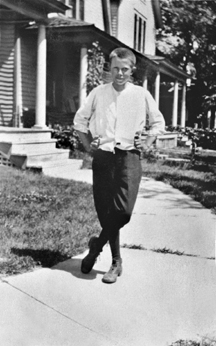 |
| |
BORN GROWN UP
|
Ernest Lawrence was "born grown up," Gunda Jacobson often said
when speaking of her eldest son. Gunda and her husband, Carl Lawrence, both
the offspring of Norwegian immigrants, met while teaching at the high school
in Canton, South Dakota, where Carl was also the superintendent of schools.
They were married on August 22, 1900, and Ernest was born the following
year. In keeping with a Norwegian tradition, his name would have been drawn
from the names of his grandfathers, Erik and Oles. Believing there were
too many Norwegians named Erik and Oles, Carl Lawrence took liberties with
the tradition.
Gunda contracted typhoid within a week of Ernest's birth, and for years
afterwards she would worry about his inability to gain weight - his childhood
nickname was "Skinny," even though he would grow to just over
six feet tall and weigh about 180 pounds most of his adult life. She also
worried about his incessant curiosity. Playing with matches at the age
of two, he set fire to his clothes and was saved by Gunda in the nick
of time.
According to Gunda, even though Ernest was "born grown up,"
he never outgrew his boyish enthusiasm. "Ernest was always of a happy
disposition and life to him seemed to be one thrill after another, but
he was also always persistent and insistent!"
His best friend growing up was Merle Tuve, who would also go on to become
a highly accomplished nuclear physicist. Together the boys constructed
a very early short-wave radio transmitting station. Lawrence would later
apply his short-wave radio experiences to the acceleration of protons.
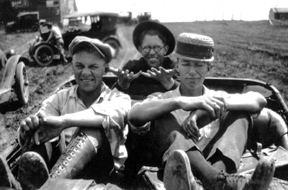 |
|
Lawrence received a B.S. degree in chemistry in 1922 from the University
of South Dakota. He worked his way through college by selling kitchenware
to farming households. This training would later serve him well when in
his selling of scientific projects to government officials and funding
agencies. Lawrence began his college career as a premed student, but switched
to physics under the guidance of Dean Lewis Akeley, whose picture would
always hang in Lawrence's office along with Lawrence's scientific heroes,
Arthur Compton, Niels Bohr, and Ernest Rutherford. Akeley tutored Lawrence
privately and sent him to the University of Minnesota, where he received
his M.A. in physics in 1922. At Minnesota, he came under the guidance
of William Francis Gray Swann, a physics professor and accomplished cellist
who steered Lawrence into electromagnetic theory and on to Yale University,
from which he would receive his Ph.D. in physics in 1925.
Even as he accepted an assistant professorship at Yale, Lawrence was
being courted by U.C. Berkeley, which was most anxious to develop its
small physics department. While a professor at Yale he in turn courted
a Vassar undergraduate named Mary "Molly" Blummer, who happened
to be the daughter of the dean of the Yale Medical School. Lured by the
promise of less teaching and more research, Lawrence accepted an associate
professor position at Berkeley in 1928, just a few days following his
27th birthday.
| |
ERNEST LAWRENCE DURING
HIS EARLY YEARS AT THE UNIVERSITY OF CALIFORNIA AT BERKELEY, SITTING
IN FRONT OF THE BUILDING THAT WOULD LATER BECOME THE RADIATION LABORATORY.
|
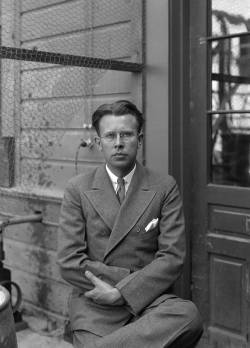 |
Within three years, he was made the youngest full professor on the Berkeley
faculty, invented the cyclotron, and become engaged to Molly, whom he
would marry in 1932. The cyclotron would be patented in Lawrence's name,
but he never asked for any royalties, and he encouraged and helped other
laboratories throughout the world to build cyclotrons. Lawrence was also
the legal inventor of the Calutron isotope separator - but he assigned
the patent rights to the U.S. government for a fee of one dollar.
"Although he greatly enjoyed the luxuries that came with wealth
and encouraged others to invent for profit in peripheral areas, Lawrence
felt that it was unwise to foster the scientific discoveries of developments
for personal profit," Alvarez wrote in his memoirs.
For Lawrence the issue had to do with placing restraints on the open
exchange of ideas between scientific colleagues. "Patent-consciousness,"
he often said, "might turn back the pages of progress."
In 1939, Lawrence became the first person to win a Nobel Prize for work
done entirely on a U.C. campus; he was also the first professor from a
public university as well as the first native of South Dakota to do so.
He won the prize in physics "in recognition of his invention of the
cyclotron, of its development, and of the results gained therefrom, especially
with reference to the production of artificially radioactive elements."
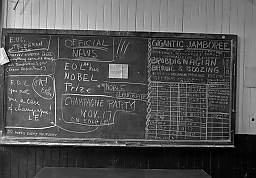 |
| THE BLACKBOARD
IN THE OLD RADIATION LAB ANNOUNCED LAWRENCE'S NOBEL PRIZE FOR THE
INVENTION OF THE CYCLOTRON. |
Upon receiving word of his historic victory, Lawrence said, "It
goes without saying that it is the laboratory that is honored."
The Radiation Laboratory was officially established in 1936. Since 1931
Lawrence and his team had occupied a two-story, clapboard-sided wooden
building that had been constructed in 1902. Located near Le Conte Hall,
home of the UC Berkeley Physics Department, it was the first of the modern
labs in which experimentalists could choose to collaborate on joint projects
or work on their own research. It would also become the first lab in which
engineers, led by William Brobeck (who would become an assistant Rad Lab
director), were treated as equal partners in experiments with scientists.
The Lab operated round the clock, seven days a week, and those who did
not put in 70-hour shifts failed to follow the example set by Lawrence.
The only time the Rad Lab was deserted was on Monday nights for two hours
during the meeting of Lawrence's beloved "Journal Club," in
which Rad Lab members met to swap ideas and information. The brilliant
Robert Oppenheimer was a frequent participant, often in debate with Lawrence.
"Oppie could always out argue him, but logic or not, Ernest was usually
right," recalled Philip Abelson.
The Radiation Laboratory came into existence as the country was sliding
into the bottom-scraping depths of the Great Depression. Yet by 1939 the
laboratory and its machines had outgrown campus housing. Lawrence was
proposing to build a 100 MeV cyclotron with the potential to create artificial
chain reactions and, as he stated, "unlock the vast storehouse of
nuclear energy."
 |
|
In the spring of 1940, the Rockefeller Foundation pledged $1.4 million
to fund a "giant cyclotron," as Lawrence called it, with a magnet
face 184 inches in diameter on the hillside above the Berkeley campus.
Before construction could begin, World War II erupted. Lawrence recruited
a stellar group of young nuclear physicists and chemists, including McMillan,
Alvarez and Seaborg, to fight the scientific war. Much has been written
about the enormous contributions Lawrence and his "boys" made
to developing the electromagnetic separation of uranium-235 that resulted
in the Hiroshima bomb. However, Lawrence was also heavily involved in
launching the MIT Radiation Laboratory and its contributions to radar
and the San Diego Anti-Submarine Project and its underwater sound laboratories.
After the victory over the Axis powers, Lawrence completed his giant
machine as the world's first synchrocyclotron able to energize protons
to 350 MeV, rather than the 70MeV it might have achieved as a cyclotron.
This synchrocyclotron had five times the output of a regular cyclotron.
With the completion of this machine, Lawrence returned to active research,
using deuteron stripping to personally discover nitrogen-17.
For the next several years, he devoted himself to basic scientific research
at the Radiation Laboratory, taking great personal interest not only in
nuclear physics but also in photosynthesis, medical physics, and nuclear
chemistry. Stories of Lawrence dropping by in the middle of the night
to ask young investigators what they were doing became legend.
In 1948, Lawrence went before the Atomic Energy Commission to procure
funding for a 6.2 BeV proton synchrotron that would be called the "Bevatron"
and would be the site of many significant discoveries, including the antiproton.
After the Soviet Union exploded its first nuclear device in 1948, Lawrence
was drawn into President Truman's decision to build a thermonuclear or
"H" bomb. By 1952, concerned that a lack of competition for
Los Alamos was hampering scientific progress, Lawrence lobbied for and
won approval to establish a second national weapons laboratory at Livermore.
At the same time, he took up a "hobby" and invented a type of
color television tube that is still in use today.
By 1958, Lawrence, having been a key figure in releasing the nuclear
genie from the bottle, became a key figure in trying to put it back. Despite
suffering from a serious flare-up of his chronic colitis, he traveled
to Geneva to participate, at the request of President Eisenhower, in negotiations
with the Soviet Union on a proposed treaty that would ban the testing
of nuclear weapons. The strain proved too much, and Lawrence was rushed
back to a hospital at Stanford for surgery. During his final days, he
confided to his wife, Molly, "I wish I'd taken more time off. I would
have liked to, you know, but my conscience wouldn't let me."
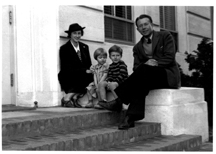 |
|
Ernest Lawrence died on Aug. 27, 1958, at the age of 57. He was survived
by Molly and their six children, John Eric, Margaret, Mary, Robert, Barbara,
and Susan. He had won virtually every major award in his field. Said Alvarez
in his memoirs, "For those who had the good fortune to be close to
Lawrence both personally and scientifically, he will always seem a giant
among men." Ernest Orlando Lawrence is the founder and namesake of
this laboratory and, as employees here, we are all a part of his legacy.
"This laboratory is his legacy. There is no other
laboratory quite like this anywhere. And it is really because it was created
by the science, the inspiration, the strength of Ernest Lawrence."
—Charles V. Shank, Director,
Ernest O. Lawrence Berkeley
National Laboratory
|


